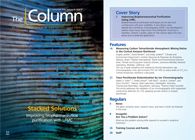Improving Biopharmaceutical Purification Using LFMC
Biopharmaceutical purification techniques can be slow and cumbersome with poor scalability. A new device using laterally-fed membrane chromatography (LFMC) was developed to address these issues. Raja Ghosh from McMaster University in Hamilton, Ontario, Canada, spoke to The Column about this new device and its potential applications.
Photo Credit: Simon Barnes / EyeEm/Getty Image

Biopharmaceutical purification techniques can be slow and cumbersome with poor scalability. A new device using laterally-fed membrane chromatography (LFMC) was developed to address these issues. Raja Ghosh from McMaster University in Hamilton, Ontario, Canada, spoke to The Column about this new device and its potential applications. - Interview by Lewis Botcherby
Q. What is laterally-fed membrane chromatography (LFMC)?
A: Membrane chromatography, which uses a stack of microporous membranes as separation media (1), is a fast and scalable alternative to column chromatography. While this technique is now widely used to remove viruses, endotoxins, and host cell proteins from biopharmaceutical products, currently used devices make it unsuitable for highâresolution multi-component separations. LFMC devices have been designed specifically to address this drawback - that is, low-resolution.
Q. How did the idea of using LFMC for biopharmaceutical purification arise?
A: An ideal biopharmaceutical purification technique should combine high resolution with high productivity, and should be scalable. Resin-based column chromatography gives high resolution but is slow and poorly scalable. Membrane chromatography using currently available devices is fast and scalable but suffers from poor resolution. Through the development of LFMC devices, we are trying to combine high resolution with high productivity and scalability.
Q. Why did you decide LFMC would provide a solution?
A: We carefully examined the different current membrane chromatography devices to identify their respective limitations. The novel LFMC design that we came up with satisfactorily addressed all of these. The initial LFMC device had a complicated design and the prototype could only be made by 3D printing. The devices we now routinely use are simpler in design, and these can be fabricated by machining or injection moulding.
Q. What does LFMC offer over existing column-based techniques?
A: LFMC has been developed specifically for combining high resolution with high productivity (2,3). While peak resolution obtained with LFMC is similar to that obtained with columns chromatography, productivity could potentially be higher by an order of magnitude. LFMC is also more scalable than column chromatography.
Q. What is unique about the device you developed?
A: The most unique feature of the LFMC device is its flow distribution arrangement, which reduces the solute residence time distribution within the membrane bed, leading to dramatic improvements in separation. We have discussed this in detail in a recent paper (4) based on theoretical and experimental analysis of hydraulic flow-paths. Factors likely to affect efficiency of LFMC are discussed using a simple electrical circuit analogy.
Q. Can you illustrate the benefits of your LFMC device with a practical example?
A: We have tested our device using real application case studies such as the removal of monoclonal antibody aggregates, the purification of PEGylated proteins, and the purification of monoclonal antibodies from transgenic sources. We have already presented some of these results in conferences such as the 2015 American Institute of Chemical Engineers Meeting, the 2015 PacificChem Meeting, and the 2016 American Chemical Society Meeting. We hope to publish some of these results in journal articles in the near future.
Q. What other applications could LFMC be suitable for?
A: We are currently working on the development of ultra-fast LFMC methods for analysis of monoclonal antibody aggregates and charge variants. We are able to perform these separations with excellent resolution in less than 2 min, which is significantly faster than that possible even with ultrahigh-performance liquid chromatography (UHPLC). The design of the LFMC device could also be applied in the development of packed bed reactors because control of residence time distribution is also important with these devices.
Q. How big an impact do you think LFMC could make within the biopharmaceutical industry? And how soon?
A: We are confident that LFMC will make a big impact on bioprocessing within the next five years because it promises benefits such as speed, scalability, and economy. Moreover, it is relevant to both analytical and preparative separations.
References
- T.B. Tennikova and F. Svec, J. Chromatogr. A 646, 279–288 (1993).
- R. Ghosh and P. Madadkar, US Provisional, 62304379, 7 March 2016.
- P. Madadkar, Q. Wu, and R. Ghosh, J. Membr. Sci. 487, 173–179 (2015).
- R. Ghosh, P. Madadkar, and Q. Wu, J. Membr. Sci.516, 26–32 (2016).

Raja Ghosh is Professor of Chemical Engineering at McMaster University, Canada. His research interests are primarily in the areas of membrane science and technology, and chromatography for purification of protein biopharmaceuticals such as monoclonal antibodies. Other areas of interest include membrane bioreactors for biopharmaceutical production and drug delivery systems for proteins. He has authored two books, Protein Bioseparation Using Ultrafiltration and Principles of Bioseparations Engineering, has published over 80 research papers in peer-reviewed journals, and several chapters in edited books. Professor Ghosh obtained his doctorate degree from Oxford University, UK. He began his academic career in 1999 as a departmental lecturer at Oxford University before moving to McMaster University in 2002.
E-mail:rghosh@mcmaster.ca
